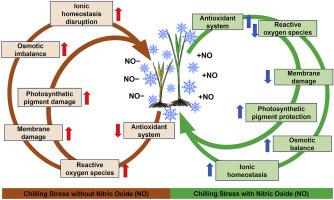当前位置:
X-MOL 学术
›
Nitric Oxide
›
论文详情
Our official English website, www.x-mol.net, welcomes your
feedback! (Note: you will need to create a separate account there.)
Insights into nitric oxide-mediated water balance, antioxidant defence and mineral homeostasis in rice (Oryza sativa L.) under chilling stress.
Nitric Oxide ( IF 3.2 ) Pub Date : 2020-04-10 , DOI: 10.1016/j.niox.2020.04.001 Abdullah Al Mamun Sohag 1 , Md Tahjib-Ul-Arif 2 , Sonya Afrin 3 , Md Kawsar Khan 4 , Md Abdul Hannan 1 , Milan Skalicky 5 , Md Golam Mortuza 1 , Marian Brestic 6 , M Afzal Hossain 1 , Yoshiyuki Murata 3
Nitric Oxide ( IF 3.2 ) Pub Date : 2020-04-10 , DOI: 10.1016/j.niox.2020.04.001 Abdullah Al Mamun Sohag 1 , Md Tahjib-Ul-Arif 2 , Sonya Afrin 3 , Md Kawsar Khan 4 , Md Abdul Hannan 1 , Milan Skalicky 5 , Md Golam Mortuza 1 , Marian Brestic 6 , M Afzal Hossain 1 , Yoshiyuki Murata 3
Affiliation

|
Being a chilling-sensitive staple crop, rice (Oryza sativa L.) is vulnerable to climate change. The competence of rice to withstand chilling stress should, therefore, be enhanced through technological tools. The present study employed chemical intervention like application of sodium nitroprusside (SNP) as nitric oxide (NO) donor and elucidated the underlying morpho-physiological and biochemical mechanisms of NO-mediated chilling tolerance in rice plants. At germination stage, germination indicators were interrupted by chilling stress (5.0 ± 1.0 °C for 8 h day-1), while pretreatment with 100 μM SNP markedly improved all the indicators. At seedling stage (14-day-old), chilling stress caused stunted growth with visible toxicity along with alteration of biochemical markers, for example, increase in oxidative stress markers (superoxide, hydrogen peroxide, and malondialdehyde) and osmolytes (total soluble sugar; proline and soluble protein content, SPC), and decrease in chlorophyll (Chl), relative water content (RWC), and antioxidants. However, NO application attenuated toxicity symptoms with improving growth attributes which might be related to enhance activities of antioxidants, mineral contents, Chl, RWC and SPC. Furthermore, principal component analysis indicated that water imbalance and increased oxidative damage were the main contributors to chilling injury, whereas NO-mediated mineral homeostasis and antioxidant defense were the critical determinants for chilling tolerance in rice. Collectively, our findings revealed that NO protects against chilling stress through valorizing cellular defense mechanisms, suggesting that exogenous application of NO could be a potential tool to evolve cold tolerance as well as climate resilience in rice.
中文翻译:

对低温胁迫下水稻(Oryza sativa L.)中一氧化氮介导的水平衡,抗氧化防御和矿物质体内稳态的见解。
水稻(Oryza sativa L.)是一种对寒冷敏感的主粮,容易受到气候变化的影响。因此,应通过技术手段来提高稻米抵抗寒冷胁迫的能力。本研究采用化学干预,如应用硝普钠(SNP)作为一氧化氮(NO)供体,并阐明了NO介导的耐寒性在水稻植株中的潜在形态生理生化机制。在发芽阶段,发芽指标被低温胁迫(5.0±1.0°C,第8天第1天)打断,而用100μMSNP预处理显着改善了所有指标。在苗期(14天大),低温胁迫导致生长发育迟缓,具有明显的毒性,同时生化标记物也发生了变化,例如,氧化应激标记物(超氧化物,过氧化氢,丙二醛和丙二醛)(渗透性总糖;脯氨酸和可溶性蛋白质含量,SPC),叶绿素(Chl),相对水含量(RWC)和抗氧化剂含量降低。但是,NO的施用可减轻毒性症状,并具有改善的生长特性,这可能与增强抗氧化剂的活性,矿物质含量,Chl,RWC和SPC有关。此外,主成分分析表明,水分失衡和氧化损伤增加是造成冷害的主要因素,而NO介导的矿物质稳态和抗氧化防御能力是水稻耐冷性的关键因素。总的来说,我们的研究结果表明,NO通过增强细胞防御机制来防御寒冷压力,
更新日期:2020-04-10
中文翻译:

对低温胁迫下水稻(Oryza sativa L.)中一氧化氮介导的水平衡,抗氧化防御和矿物质体内稳态的见解。
水稻(Oryza sativa L.)是一种对寒冷敏感的主粮,容易受到气候变化的影响。因此,应通过技术手段来提高稻米抵抗寒冷胁迫的能力。本研究采用化学干预,如应用硝普钠(SNP)作为一氧化氮(NO)供体,并阐明了NO介导的耐寒性在水稻植株中的潜在形态生理生化机制。在发芽阶段,发芽指标被低温胁迫(5.0±1.0°C,第8天第1天)打断,而用100μMSNP预处理显着改善了所有指标。在苗期(14天大),低温胁迫导致生长发育迟缓,具有明显的毒性,同时生化标记物也发生了变化,例如,氧化应激标记物(超氧化物,过氧化氢,丙二醛和丙二醛)(渗透性总糖;脯氨酸和可溶性蛋白质含量,SPC),叶绿素(Chl),相对水含量(RWC)和抗氧化剂含量降低。但是,NO的施用可减轻毒性症状,并具有改善的生长特性,这可能与增强抗氧化剂的活性,矿物质含量,Chl,RWC和SPC有关。此外,主成分分析表明,水分失衡和氧化损伤增加是造成冷害的主要因素,而NO介导的矿物质稳态和抗氧化防御能力是水稻耐冷性的关键因素。总的来说,我们的研究结果表明,NO通过增强细胞防御机制来防御寒冷压力,











































 京公网安备 11010802027423号
京公网安备 11010802027423号